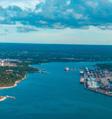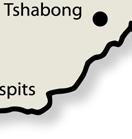AFRICAN BUSINESS

TACKLING THE GENDER PAY GAP
More female-run businesses will mean a bigger economy and more opportunities for everyone, says NTHAKOANA MAEMA , CEO of impact incubator, Oribi.





|















More female-run businesses will mean a bigger economy and more opportunities for everyone, says NTHAKOANA MAEMA , CEO of impact incubator, Oribi.





|























The Gateway to learning is infinite… Get ahead of the curve and stand out from amongst the crowd through Executive Education at Wits Business School. Develop cutting-edge skills for revolutionary leaders.



























































Welcome to the Journal of African Business. The first issue of the journal was published in 2020 as an annual publication. Since then, the quarterly format has been adopted, giving our team more opportunities to bring to readers upto-date information and opinions and offering our clients increased exposure at specific times of the year.
We continue to cover a broad range of topics, ranging from energy and mining to tourism and skills development. Issues relating to the emerging green economy are becoming more relevant by the day. On a continent where large numbers continue to go without electricity, there is a special urgency to this debate. In this edition, a searching analysis is included on the prospects of green hydrogen for developing countries. Rod Crompton and Bruce Douglas Young of the Africa Energy Leadership Centre, University of the Witwatersrand, point out some of the potential potholes on the way to exploiting this greener power source, transport and cost being two big concerns. Th is article fi rst appeared in The Conversation AFRICA.
Where green hydrogen has future potential, the green minerals that Africa has in abundance are already driving investment as the world looks to make the transition away from fossil fuels. The mining team at legal alliance LEX Africa argue that Africa is well positioned to benefit. African women are benefitting from better access to financing through the medium of mobile
phones, as Rashi Gupta, Group Chief Operating Officer at MFS Africa outlines, but Nthakoana Maema, CEO of impact incubator, Oribi, is clear that with regard to the gender pay gap, much still needs to be done.



A snapshot of some of the continent’s busiest regions with regard to the construction sector highlights some of the factors underpinning projects, such as infrastructure spending. Travel and logistics are the focus of three articles. Trends shaping supply chains is the subject of one article. Another looks at how access to African countries has improved for travelling Africans, as illustrated by the results of the seventh 2022 Africa Visa Openness Index. Finally, ride-hailer Bolt has established itself in several African countries, pointing the way to a new kind of mobility. An important survey of CEOs has been produced. We publish the executive summary of Africa CEO Trade Survey Report 2022 by the Pan African Private Sector Trade and Investment Committee (PAFTRAC).
The tourism industry is in the spotlight as the Radisson Group, winners of the Leading Hotel Group in Africa award, give details of their expansion plans for the continent.








Global African Network is a proudly African company which has been producing region-specific business and investment guides since 2004, including South African Business and Nigerian Business, in addition to its online investment promotion platform www.globalafricanetwork.com.



 JOHN YOUNG Editor, Journal of African Business
JOHN YOUNG Editor, Journal of African Business
Email: john.young@gan.co.za
Editor: John Young
Publishing director: Chris Whales
Managing director: Clive During
Online editor: Christoff Scholtz
Design: Salmah Brown. Production: Yonella Ncaba
Ad sales: Venesia Fowler, Tennyson Naidoo, Sam Oliver, Tahlia Wyngaard, Gavin van der Merwe, Graeme February, Shiko Diala, Gabriel Venter and Vanessa Wallace



Administration & accounts: Charlene Steynberg, Kathy Wootton, Sharon Angus-Leppan

The









African


FOREWORD


From the editor’s desk.

THE GENDER PAY GAP IS STILL AN UNCOMFORTABLE REALITY
There’s much to be positive about, says Nthakoana Maema, CEO of impact incubator, Oribi, but still a lot more to be done.


THE LOGISTICS INDUSTRY NEEDS TO ADAPT TO NEW TRENDS













Flexibility and agility are the key to servicing clients.

AFRICA IS MAKING PROGRESS ON VISA-FREE TRAVEL


Burundi, Djibouti and Ethiopia have shown the most progress in easing travel restrictions according to the seventh 2022 Africa Visa Openness Index.
RIDING FORWARD TO A GREEN FUTURE IN AFRICA
Regional Manager for East and Southern Africa at Bolt, Takura Malaba, argues that ridehailing has come a long way from the days when it was seen as a flash in the pan.


GLOBAL DEMAND FOR GREEN MINERALS BOOSTS AFRICAN PROSPECTS

Africa is well positioned to benefit from the green mineral boom.

CAN GREEN HYDROGEN WORK FOR AFRICA?
Big problems must be solved before green hydrogen can be extensively used, as Rod Crompton and Bruce Douglas Young of the Africa Energy Leadership Centre explain.
CONSTRUCTION HOTSPOTS

Infrastructure, renewable energy and hospitality are driving renewed growth in the African construction sector. By John Young
MOBILE MONEY IS EMPOWERING WOMEN IN AFRICA

Financial inclusion is the most effective way of reducing inequalities, writes Rashi Gupta, Group Chief Operating Officer at MFS Africa.
AFRICAN CEOS ARE POSITIVE ABOUT THE AFCFTA


The Pan African Private Sector Trade and Investment Committee ( PAFTRAC ) has published its Africa CEO Trade Survey Report 2022 assessing the impact of the Af CFTA on African trade.
THE RADISSON HOTEL GROUP IS TARGETING AFRICAN GROWTH


As Radisson celebrates winning the Leading Hotel Group in Africa Award, the group outlines its strategy in building its African footprint beyond the current capacity of nearly 8 000 rooms.



COUNTRY PROFILE: BOTSWANA

The Jwaneng Mine is the richest diamond mine in the world by value.




COUNTRY PROFILE: ZAMBIA
Copper’s importance to the global economy is good for investment.



#EmbraceEquity was the most popular hashtag on Twitter and Instagram around the world on 8 March 2023. The slogan was the tagline for International Women’s Day (IWD) and in the age of instantly shareable messages, it travelled far and wide.





















“What we’re seeing is a coordinated effort globally to make the lives of girls and women better,” says Nthakoana Maema, CEO of impact incubator, Oribi.

























The Oribi incubation model helps women discover economic freedom through collective networks and entrepreneurship development.







Oribi also tackles long-lasting legacy issues and aims to foster a society where gender norms are challenged. “The income and pay gap still exists in South Africa and the world,” Maema says, “and we need to empower all stakeholders to take women’s issues seriously.” The gender pay gap remains a global issue that’s of particular concern in Africa and South Africa, where estimates put the median wage difference between men and women at a high of 35%. More female business owners mean a bigger economy with a greater number of opportunities for everyone.

These businesses often benefit wider society as a whole. What challenges still need to be tackled for female employees and business owners?



























































More and more women are entering male-dominated spheres but their ability to attract funding for their business is often stymied. “Property ownership is typically used as collateral for a business loan, yet female entrepreneurs often don’t qualify,” Maema notes. “Banks can be rigid in their approach, and when credit is offered, it’s often a reduced sum. This, despite the fact that female
entrepreneurship creates jobs, lessens poverty and improves living standards.” Typically, female entrepreneurs might turn to the government for assistance, but the process tends to be less than positive with red tape the norm.






















Often, government agencies don’t understand what the money is needed for, responses lack a gendered lens and so female entrepreneurs are forced to use their own savings or look for the help of an angel investor. “Regulatory red tape is a reality for everyone,” Maema says, “but there’s an unspoken yet pervading assumption that female entrepreneurs might be less capable of handling the loan, and so even more stumbling blocks are put up in their way.”



























































The goal is to stop signalling to children that they’re better at different things because of their gender, Maema notes, because all that does is limit people. In reality, while women entrepreneurs do sometimes choose jobs in the care economy, there are countless examples of female inventors, engineers and scientists who deserve a spotlight: incredible women like Dr Keabetswe Ncube, a Genomics Specialist at Inqaba Biotechnical, or Dr Sylvia Fanucchi, a Protein Biochemist and Senior Lecturer at Wits University.






“It’s absolutely okay for a woman to want to work in the care economy – this work should be valued – but they should also feel free to enter a ‘male-dominated’ field,” Maema says. “Yet we rarely publicise the women who do valuable work in the sciences and so this creates the misconception that there’s a neat little box for each gender.”

There’s much to be positive about, says Nthakoana Maema, CEO of impact incubator, Oribi, but still a lot more to be done.

 Women are in the room and increasingly making decisions, but are they being equitably paid?
Women are in the room and increasingly making decisions, but are they being equitably paid?



There’s much to be positive about, Maema says, but still a lot more to be done. The gender pay gap remains a global issue that’s of particular concern in South Africa. What’s more, unemployment figures are high among women. As President Cyril Ramaphosa noted at the Second Women Economic Assembly in 2022, 47% of South African women aged between 15 and 64 are deemed “economically inactive”.
































“Again, it’s a question of opportunity and ensuring all genders have equal access and shorter pathways to the heart of the value chain,” Maema says. Ultimately, despite these challenges, this is one of the few countries in the world where the number of women starting their own business is actually growing, something that Maema says can only be a net positive. “More female business owners means a bigger economy with a greater number of opportunities for everyone.” And these businesses often benefit wider society as a whole. Look no further than Sibongile Mongadi’s Uku’hamba project, which is building prosthetic limbs from affordable materials or the SME-funding firm Akiba, co-founded by Tebogo Mokwena. “Going forward,” Maema says, “the key is to incubate and support budding entrepreneurs while ensuring marginalised groups are equipped to navigate South Africa’s corporate machinery.” Fostering talent this way is the Oribi vision through and through. Discover more about Oribi and its incubator model at https://www.oribi.org.za/





























Oribi is a non-profit incubator dedicated to catalysing high-impact entrepreneurship with, from and for marginalised people and places and fostering sustainable development in South Africa. We collaborate with many stakeholders to unlock individual and collective action and address social, economic and environmental challenges. Through a systems approach, we enable people to identify needs, prioritise solutions and implement impactful social enterprises. Our focus areas include community enablement, food systems, entrepreneurial support, inclusivefinancing support, access to networks and policy engagement. Thanks to technical support from Value for Women, we apply a gender lens in our actions. Join us in creating positive change for a brighter future. Visit www.oribi.org.za to learn more.









Nthakoana Maema has a strong commitment to creating financially thriving and inclusive economies in South Africa. She leverages her extensive experience as a development strategist spanning over 17 years. Passionate about sustainable cities, social entrepreneurship and promoting youth and gender inclusion, Nthakoana approaches complex challenges through the lens of equity and systems thinking. Her diverse educational background includes studies in Business Science with a focus on Finance, Design Thinking and NPO/SE Management. Recently, she furthered her expertise by completing a Postgraduate Diploma in Sustainable Development at Stellenbosch University. Nthakoana is the founder of FutureProof Consultancy, where she empowers leaders and teams to build resilience and cultivate a culture of innovation.


Young African women who want to pursue careers in science, technology, engineering or mathematics (STEM) have increasing numbers of inspiring examples to help frame and fan their ambitions. There are also more organisations, social media groups and media outlets focussing on the subject of women in STEM. We focus here on three. WORDS THAT COUNT is a website which tells stories about women who are successful in STEM careers. The founder and content director is Winnie Nakiyingi, a Ugandan statistician who has worked in several African countries and Canada, but who describes most of her work as being in “academia and STEM advocacy”.
Some examples of career stories that are featured on the website: + Jordana Esther Muwanguzi, Uganda, computational biologist + Papama Lose, South Africa, diagnostic radiographer + Dr Jennifer Batamuliza, Rwanda, data scientist
+ Dr Keabetswe Ncube, pictured with a small goat, is a genomics specialist works at Inqaba Biotechnical on genetic testing that can improve stock animals. She also has her own agricultural consulting company.


Inspiring African Women bring together women in STEAM fields to celebrate our unique experiences and diverse perspectives. We aim to create an inclusive and empowering community by celebrating the unique experiences of women in these fields and providing them with opportunities to thrive and excel.
InspiringFifty SA describes itself as a non-profit initiative that benchmarks and awards the 50 most inspiring women in #STEM in partnership with @cocreatesa








TThe logistics industry battled a number of challenges in 2022, among which were the war in Ukraine and turmoil over China’s strict Covid-19 policies.
Despite this turmoil, the world emerged from the worst of the pandemic, meaning that supply chains returned to some degree of normality despite the conflict in Eastern Europe.
Within this context, a number of significant developments occurred within the industry itself, and the impact of these is anticipated to be felt this year and beyond.
From a shipping perspective, acquisitions by shipping lines last year changed the landscape to some extent. These companies were highly profitable between 2019 and 2022 and many used some of these profits to enter various landside logistics businesses – from warehousing to transport and IT-related services.
Going forward, this shake-up is expected to create new alliances within the industry, with old alliances becoming new competitors.
Another major development last year was the increased adoption of technology and automation to drive efficiencies and reduce costs.
According to Bidvest International Logistics (BIL) Head of Sales Rhett Oertel, in 2023 technology adoption will keep driving supply-chain companies in the direction of automation while increasing visibility, improving predictive analytics and optimising supply chains.
“The impact of blockchain, artificial intelligence (AI) and electric vehicles in the supply-chain industry will be ongoing. Blockchain is in use in trade financing and contract execution and is even tracking AI use in the supply chain to help with forecasting,” says Oertel.
It is a view shared by Oertel’s colleague and BIL Director Marcus Ellappan, who says that with the logistics industry under constant pressure to reduce costs, businesses increasingly will be looking at automating processes.


Another trend that emerged in 2022 and should become even more prevalent is Environmental, Social and Governance (ESG) compliance.

“ESG will remain for years to come as companies focus on reducing their carbon footprint and reducing their overall impact on the environment. The emphasis on ESG is at the forefront of a lot of discussions nowadays as companies look to partner with people who, like them, invest in green technologies and initiatives,” Oertel says.
This will entail companies needing to be more involved in the entire lifecycle of products and packaging.

For South African businesses, loadshedding and high fuel prices remain a huge problem. As a result, Ellappan expects to see them focusing a lot more on efficient management of fuel usage and renewable energies. As he puts it, “Burning fuel


in generators is not the way to go.” The industry is of course keeping a watchful eye on tensions between certain countries. In the event of these escalating, new policies that will have an impact on trade could be introduced. Trade agreements or changes in tariffs, for example, will affect the flow of goods and the cost of doing business.
Oertel concludes, “I do believe as a company one needs to be aware of these developments and strategically apply the required focus on the aspects that will impact your market in the most effective way.
“All in all, supply-chain business models seem to be changing and the need for flexibility and agility is becoming key to servicing clients. E-commerce is continually growing. This in the end leads to the demand for faster and more flexible and reliable supply chains.”
Ellappan confirms this assessment: “Coming out of Covid, together with various global supply-chain issues, businesses are forced to become more efficient. The benefits of digital transformation, risk management and ESG will most certainly talk back to a business’s bottom-line results and sustainability.”


BIL is one of South Africa’s largest logistics businesses, owned by services, trading and distribution powerhouse Bidvest. BIL provides an end-to-end supply-chain solution across a number of different industries. It offers international import and export services, using road, sea and air. BIL is able to clear, warehouse, fulfil and distribute through final-mile distributing services. The company has massive coverage and access to a worldwide forwarding network. Its leading technological capability gives customers full visibility of their orders 24/7, whether they’re single items or bulk, express or deferred.
 Marcus Ellappan
Marcus Ellappan




The Gateway Airport Authority Limited has ambitious plans for Limpopo’s most important airport, writes Mokgadi
With the appointment of a new management team, a focus on restoration and improvements in infrastructure, the new face of Polokwane International Airport (PIA) is rapidly taking shape.
PIA is situated 9km north of the City of Polokwane and like some of the more-established airports in South Africa, it was previously an airforce base. The Limpopo Provincial Government took ownership of the converted facility in 1995. The Gateway Airport Authority Limited (GAAL) manages and operates the airport, together with other selected airports entrusted to the Limpopo Provincial Government.
The Limpopo government taking over the airport was the start of its journey towards a competitive civil-aviation infrastructure to be reckoned with. Although troubled with infrastructure failures and non-compliance issues in the past, the airport is now on its way to full recovery and becoming a true destination of choice for both passenger and cargo traffic.
The board quickly realised it was critical to appoint new senior management and fill critical key positions to enable maintenance of infrastructure and improving compliance with SACAA and ICAO requirements.
Polokwane International Airport is equipped with two runways sufficient to accommodate large aircraft of the size of Boeing 747 and Airbus A346.
In the medium term, GAAL is planning to refurbish both runways 05/23 and 01/19 to improve the friction and strength of the runways. Runway 01/19 will also be extended by 1km to complete and join it with the taxiway and threshold that has already been built in anticipation of this extension. This will allow the airport to handle heavy cargo operations, which is the ultimate business objective set for 2024-2029.
The airport has an apron facility of 74 000 square metres of parking space and is able to accommodate nine B747-type aircraft and 13 B737/A321-type aircraft. Furthermore, the airport has 16 hangers of 540m² and one 6 450m² hangar, with the immediate potential of setting up multi-functional cargo facility.
Runway 05/23 is equipped with a runway-lighting system and it will soon be converted from halogen to LED lights, thereby reducing maintenance costs and improving reliability and availability.
This instrument runway is also equipped with a simple approach-lighting system to complement the RNAV procedure and to enable access to the airport in bad weather conditions. Plans are at an advanced stage to replace the current Precision
Matli, Acting CEO.
Approach Path Indicator (PAPI) system with an advanced LED PAPI system. This system enables the pilots to observe their approach path towards the runway and is critical in ensuring a safe landing. Compared to the old system, the new LED PAPI system has lower power consumption, clearer white/ red transition and an electronic angle display, thereby enhancing monitoring by ground electrical personnel without requiring sophisticated additional systems, a reduced calibration frequency and fail-safe built-in functionality to ensure out-of-tolerance automatic switch off.
Availability of aviation fuel is critical for airport operations. Currently the airport has outsourced the provision of JETA1 and AVGAS fuel. Furthermore, GAAL is in the process of refurbishing the one-million-litre-JetA1 Fuel Farm, with an associated 30 000-litre-AVGAS facility at the airport.

Airport Rescue and Fighting protection level is currently at category 7, meaning the airport can regularly service aircraft in the categories B737-800 and A320. GAAL has appointed a service provider to repair two of its additional major trucks, which will guarantee availability of the protection level ARFFS CAT 7 and enable the airport to meet the requirements of CAT 9, similar to airports such as Cape Town and OR Tambo.
Aviation activities are the core and heart of the airport and propelling and regenerating these activities talks to the existence and survival of an airport. Current aviation activity in both passenger and cargo terms is low. Short-term interventions which are in progress include:
• Promoting the airport as a diversion airport for major domestic and international operators from June 2023.
• Introduction of cargo operations from July 2023.
• Promoting the air service between Polokwane International and OR Tambo International Airports from June 2023 to improve number of passengers using the airport.
• Introducing an additional route between Polokwane and Cape Town by March 2024.
A progressive and true destination choice for passenger and cargo operations
GAAL is mandated to manage Polokwane International and other designated airports in the Limpopo Province entrusted to the Limpopo Provincial Government in compliance with various legislative and administrative acts such as the South African Civil Aviation Authority (SACAA) and the International Civil Aviation Organization’s SARPS.


The entity is charged with managing and developing Limpopo airports to provide ease of access to our province for tourism and trade.
VISION
To lead growth of the aviation industry in Limpopo
MISSION
+ To operate and develop public airports within the province of Limpopo
+ To create and develop hub-and-spoke flight operations network in Limpopo to feed PIA
+ To develop PIA as the hub of SADC region and the north of South Africa
+ To collaborate with our key stakeholders to stimulate economic and social development for the people of Limpopo
Polokwane International Airport is ideally located as


+ a hub for the SADC region
+ a transport-shipment centre
+ a diversion airport
+ a first stop for tourists visiting Limpopo
Polokwane International Airport has
+ two runways big enough for Boeing 747 and Airbus A346
+ 17 hangars
+ Category 7 licence
+ 400 parking bays
+ Conference facilities
+ Clinic and emergency centre
+ Shops
Polokwane International Airport
Gateway Drive, Polokwane
Tel: 015 288 0122
Website: www.gaal.co.za
Photo by PixabayBurundi, Djibouti and Ethiopia have shown the most progress in easing travel restrictions according to the seventh 2022 Africa Visa Openness Index, published by the African Development Bank Group and the African Union Commission.
Despite Covid-19 lockdowns and travel disruptions, 93% of African countries have maintained or improved their score on the Africa Visa Openness Index (AVOI) relative to 2021. Two-thirds of African countries have adopted more liberal visa policies compared to six years ago.
The 2022 Africa Visa Openness Index report shows African countries making progress in their freedom of travel policies, most of which had been severely curtailed by the Covid-19 crisis.
The annual publication, prepared by the African Development Bank Group in collaboration with the African Union Commission, is now in its seventh edition and was launched on the sidelines of the 2022 African Economic Conference in Mauritius.

The report tracks visa policies adopted by African governments on three main criteria: whether entry to citizens from other African countries is visa-free, if a visa on arrival can be obtained, and whether travellers are required to obtain visas ahead of travelling to other African countries.
The 2022 report underlines the impact of the Covid-19 pandemic in 2020 and 2021, during which most countries restricted movement, both domestically and for international travel. Restrictions on international travel ranged from closing entire
borders to quarantines, screening measures, and bans on visitors from countries deemed “high risk”.
Domestic restrictions included a gamut of measures such as prohibitions on travelling between provinces, bans on non-essential movement, curfews and rules that limited gatherings.
The 2022 report reflects on renewed signs of progress: 10 countries improved their visa openness score over the past year and visa openness on the continent now exceeds that recorded during the year prior to the Covid-19 pandemic and is in line with the peak score achieved in 2020.
Progressive visa policies that increase visa-free entry or to visa on arrival policies will ensure that this positive trend continues. The use of technology and a greater adoption of eVisa systems will help fast-track the ease at which travellers can cross borders.
• African travel has become more open to African citizens in 2022, with fewer restrictions overall. There is now an even split between travel that is visa-free, and travel where a visa may be obtained on arrival at the destination country.
• Three countries, Benin, The Gambia and the Seychelles, offer visa-free entry to Africans of all other countries. In 2016 and 2017, only one country did so.
• 24 African countries offer an eVisa, five more than five years ago.
• 36 countries have improved or maintained their Visa Openness Index score since 2016.
• 50 countries have maintained or improved their Visa Openness Index score relative to 2021, usually after removing some of the visa policy restrictions implemented during the pandemic.
• 48 countries out of 54, the vast majority of African countries, now offer visa-free travel to the nationals of at least one other African country.
• 42 countries offer visa-free travel to the nationals of at least five other African countries.



Interestingly, lower-income countries account for a large share of the countries that make up the top-20 ranked countries in 2022 with liberal visa policies: 45% of countries in the top-20 on the index are classified as low-income countries, while a further 45% of countries are classified as lower middle-income.
EVisas allow prospective travellers to apply for a visa from the comfort of their home or workplace ahead of travel, streamline the application process, reduce time at borders, provide a greater measure of certainty ahead of travel, reduce the need to submit a passport for processing to consular offices and make travel safer and more secure.
African Union Commission Deputy Chairperson Dr Monique Nsazabaganwa, says of the report, “This edition links free movement to the development of regional value chains, investments, trade in services
and the AfCFTA. There is greater recognition that human mobility is key to Africa’s integration efforts.”

African Development Bank Group Acting Vice President in charge of Regional Development, Integration and Business Delivery, Marie-Laure Akin-Olugbade, remarked, “The Africa Visa Openness Index has been tracking visa openness as a measure of the freedom of movement since 2016. This year’s edition shows many African countries having greatly simplified their visa regime over the past year.”
The 2022 edition of the report showcases three countries that have made the most progress in their visa openness, namely Burundi, Djibouti and Ethiopia. Ethiopia in particular has risen several places on the index to retain its position in the continent’s top-20 performers after removing the temporary measures instituted in 2021.
In an innovation, the report provides an analysis of free movement of persons at regional economic community level in Africa. The Economic Community of West African States (ECOWAS) and the East African Community are the most open communities, with ECOWAS hosting eight of the top 10 countries.
Commenting on the report, African Development Bank Group Acting Director in charge of the Regional Integration Coordination Office Jean-Guy Afrika, said, “The Africa Visa Openness Index has tracked the evolution of visa regimes on the African continent from before the pandemic to today. As the 2022 report shows, African countries are dismantling many of the measures imposed during the pandemic. Indeed, on the whole, the continent has returned to a level of visa openness last seen just before the pandemic began.”
+ For 27% of intra-Africa travel – travel by African citizens between African countries – African citizens do not need a visa, up from 25% in 202.
+ For 27% of intra-Africa travel, African citizens can obtain a visa on arrival, up from 24% in 2021.
+ For 47% of intra-Africa travel, African citizens are still required to obtain a visa before travelling, an improvement on the 51% in 2021.
The Africa Visa Openness Index measures the extent to which African countries are open to travellers from other African countries. Published yearly since 2016, the AVOI tracks changes in countries’ scores over time to show how national policies evolve on the freedom of movement across Africa.
View the Africa Visa Openness Report at: www.VisaOpenness.org
Credit: Nairobi National Park Check-in desks at Jomo Kenyatta International Airport




Now established in cities across Africa in nations such as Ghana, Kenya, Nigeria, South Africa, Tanzania, Tunisia and Uganda, Bolt is proving that the phenomenon of ride-hailing is far from being a flash in the pan. Regional Manager for East and Southern Africa at Bolt, Takura Malaba, argues that ride-hailing has come a long way. Its humble beginnings rooted in a curious and innovative option to get around, now e-hailing has evolved into a safe and convenient transport alternative for many. He says that as more people look for reliability without the fuss, Bolt is a popular choice, empowering both passengers and drivers.

WWhen e-hailing first launched, passengers were intrigued by the innovation. However, there are still many who were sceptical about driving with a stranger. And being unsure about the processes involved is also a communication challenge. These and many other hurdles need to be overcome for Bolt to be a fully-fledged complementary service in the transport ecosystem.
By studying macro-trends like rising inflation and a much higher cost of living, we can get a feel for what the future may hold. For instance, more people –especially the young generation – are moving away from buying vehicles and don’t necessarily want to own a car. They do however still need to get from A to B, safely and affordably. We believe that many will start using riding opportunities with e-hailing platforms instead of owning their own vehicles.
At Bolt, the driver is an equally important part of the transport solution. It started with people seeing e-hailing as an opportunity to make additional income by driving, and now that’s changed. Today, countless businesses have grown out of it and there are many entrepreneurs who have turned one e-hailing car into a large fleet. Bolt has car owners who have decided to leave their current employment, whether they were truck operators or taxi drivers, simply because they prefer to work in a flexible environment with the potential to earn more and decide their own hours.
Ten years ago, when Bolt first entered South Africa, we didn’t think we could move the needle on unemployment. But now we’re at a point where we have between
Dar es Salaam, Tanzania, where Bolt offers its services.100 000 and 150 000 e-hailers on our roads. If South Africa can emulate mature markets where 1% of the employed population are e-hailing drivers, we’re looking at 500 000 to 600 000 people with gainful employment in the next couple of years, which is a significant number.

























E-hailing started with the bare minimum and was all about getting from one point to another. At the time, the team at Bolt probably thought the tech was quite sophisticated, but now we’re lightyears ahead of where we were. Safety is a cornerstone in our business, and there have been plenty of innovations in South Africa in that area. For example, we take full advantage of AI with driver-selfie verification, which combats people renting out their profiles to be impersonated by others. Using machine learning, these selfies go into government databases to be compared with the pictures found in documentation like ID photos. This means our drivers are vetted and all sign on to be safety ambassadors for our brand.

E-hailing provides drivers with great earning potential while also offering rural and township residents access to job opportunities in cities, a gap the traditional public transport simply isn’t able to fill.


E-hailing is one of the pillars to solve or at least alleviate the transport challenges we face. If you look at South African transportation as an ecosystem, we’re simply plugging into it. It’s not here to replace other public transport, but rather to provide value in the form of reliability and safety and to ensure that the price point is relevant for the consumers in our market.
which converts to a 15-20% saving in both emissions and efficiency. And this is only the first step.
It’s been an incredible journey so far with many exciting innovations. We are no longer a lifestyle convenience for a niche group of affluent people but now we are an important transportation option for many. We’ve only caught a glimpse of our potential to shape cities and empower people, and our eyes are set on the road ahead.
Bolt is the European super-app, with over 100-million customers in more than purpose a private car serves – including










45 countries across the globe. We’re making cities for people, offering better alternatives for every ride-hailing, shared cars, scooters, and food and grocery delivery.
We believe that most trips in the city don’t require the use of a personal car. At Bolt, we’re building a future in which people are no longer forced to buy a car to get around. Where people have the freedom to use transportation on demand, choosing whatever vehicle is best for each occasion.

Depending on maturity, our markets have electric vehicle market is different, but we have our sights set on a green future.
One of our agendas at Bolt is to go green and initiate sustainability programmes. Depending on maturity, our markets have electric vehicle categories and we’re looking to introduce that to Africa. Each market is different, but we have our sights set on a green future.
One area we are looking at is liquid petroleum gas kits for drivers to add to their vehicles. In essence, this allows them to run liquid petroleum alongside traditional petroleum gas,
 Passengers enjoy the flexibility of ride-hailing services.
Passengers enjoy the flexibility of ride-hailing services.


AAfrica is home to some 30% of the world’s mineral reserves, 8% of its natural gas reserves and 12% of its oil reserves, according to the United Nations.
It also has 40% of the world’s gold, up to 90% of its chromium and platinum and the largest reserves of cobalt, diamonds, platinum and uranium in the world.
Most importantly, Africa is well positioned to benefit from the global green mineral boom.
As the energy transition gathers pace, the production of certain critical minerals in the manufacture of everything from solar panels to wind turbines and electric vehicles is expected to rise by up to 500% by 2050, according to the World Bank.
It estimates that over three-billion tons of minerals and metals will be needed to deploy wind, solar and geothermal power, as well as energy storage, required for achieving a below-2°C future.
Speaking during a panel discussion on building a regional battery-mineral value chain in Africa, Antonio Pedro, acting chief of the UN Economic Commission for Africa (ECA), said Africa is home to many of the required minerals.
The Democratic Republic of Congo (DRC), for example, produces over 70% of the world’s cobalt. The DRC and Zambia together supply 10% of global copper, while Mozambique and South Africa hold significant reserves of graphite, platinum metals, lithium and more.
“We have clear opportunities not only from the global green mineral boom but also from our domestic achievements, such as the African Continental Free Trade Area, to facilitate the development of regional value chains for these green economy products,” he told delegates.
A recent BloombergNEF study underlines the fact that the DRC is a favourable location for producing sustainable battery materials for high-nickel batteries due to its abundant cobalt resources and access to hydroelectric power.
It suggests that battery precursors produced in the DRC would be cheaper, environmentally sustainable and more competitive than material produced in China, the US and elsewhere.
Mining for copper and cobalt in the DRC is on a large scale Credit: Vlad Cheţan/PexelsThe Bloomberg report estimates the global market opportunity for electric vehicles at $7-trillion by 2030 and $46-trillion by 2050.
During a panel discussion at the 2022 African Mining Indaba in Cape Town, Bushveld Minerals CEO Fortune Mojepalo said it would be necessary to develop an estimated 400 new mines, worldwide, to supply the metals that would be needed for the transition to clean energy and the production of electric vehicles.
He said Africa leads the world in six or seven of the metals essential for energy transition, including cobalt, lithium and platinum metals.
Moreover, the opportunity for Africa is not limited to the supply of metals. If downstream development, or beneficiation, took place, the economic effect would be massive.
Beneficiation is the transformation of a mineral, or a combination of minerals, into a higher-value product, which can either be consumed locally or exported.
The key constraints to progress in this direction are related to infrastructure, as pointed out by Minerals Council South Africa senior executive for environment, health and legacies, Nikisi Lesufi.
However, as World Bank global director for energy and extractives, Demetrios Papathanasiou, has noted, the assured long-term demand for transition metals would allow for long-term infrastructure development.
As developed countries seek to diversify their supply of critical minerals away from Russia and China, the economic opportunity for Africa is significant with the continent accounting for over 40% of global reserves of cobalt, manganese and platinum – key minerals for batteries and hydrogen technologies.
Besides the DRC alone producing around 70% of the world’s cobalt, Mozambique and Madagascar have some of the leading deposits of graphite, while Zimbabwe has large deposits of lithium.
China is the dominant player in the processing of mineral ores, refining 73% of cobalt, 40% of copper, 59% of lithium and 67% of nickel.
A large share of these minerals is imported in unprocessed form from elsewhere, including Africa. As the International Energy Administration reports, “China dominates production at every stage of the electric vehicles battery supply chain downstream of mining.”
China also dominates green technology value chains, producing over 80% of the world’s solar panels and over 70% of the world’s lithium-ion battery cells.
A World Bank report titled “Minerals for Climate Action: The Mineral Intensity of the Clean Energy Transition,” says the growing demand for minerals and metals provides economic opportunities for resource-rich developing countries and private-sector entities alike.
But significant challenges will likely emerge if the climate-driven clean energy transition is not managed responsibly and sustainably.
Without Climate-Smart Mining practices, negative impacts from mining activities will increase, affecting already-vulnerable communities in developing countries and the environment in which they operate.
The World Bank says the Climate-Smart Mining approach has been developed in concert with the broader UN sustainable development goals (SDG) to ensure that the decarbonisation of the mining and energy sectors also benefits resourcerich countries that host these strategic minerals and the communities directly impacted by their extraction.


“Climate-Smart Mining builds on the work the World Bank is doing to help ensure resource-rich developing countries benefit from their mineral resources and manage them in a sustainable manner, while fostering economic growth and development,” says the report. It says the World Bank wants to ensure that resourcerich developing countries also benefit from the new mineral demand by de-risking investments using sustainable and responsible resource development strategies.
Established in 1993, LEX Africa is a legal alliance of leading African law firms, managed by South African member Werksmans Attorneys for the purpose of advising local and international clients on their trade, business, investment and other activities in Africa.
We are proud to be the first and largest African legal alliance with a Pan African legal team of more than 700 lawyers providing cross-border and local African legal solutions for clients. Our track record speaks to our experience, expertise and success over the years, being consistently ranked as a Band 1 leading regional law firm network by Chambers and Partners.
LEX Africa proudly celebrates 30 years of its existence and we thank our lawyers, clients and friends who have contributed to our success. We will continue to provide world-class legal services, empower our lawyers and encourage sustainability, diversity, inclusivity and collaboration between our lawyers. These principles have guided us in building successful long-term partnerships with members and clients since our formation in 1993.
HHydrogen is used mainly to make chemicals such as fertiliser and in oil refineries. Most hydrogen in the world today is made from natural gas or coal – methods associated with large carbon-dioxide emissions. Developed countries are therefore looking to “green hydrogen” instead – produced using renewable electricity such as solar and wind power.
Global hydrogen demand reached 94-million tons in 2021 and contained energy equal to about 2.5% of global final energy consumption. Only about 0.1% of current global hydrogen production is green, but big expansions are planned.
New applications for green hydrogen are also envisaged. Since the objective of using green hydrogen is really to reduce carbon dioxide, the applications to target first should be those that will yield the largest reductions in emissions.
Michael Liebreich’s classification is a useful indicator of the potential markets for green hydrogen. At the top of that classification in terms of efficiency are the following applications: fertiliser, hydrogenation, methanol, hydrocracking and desulphurisation. In the second tier are shipping (using e-fuel or ammonia), steel, off-road vehicles, chemical feedstock and long-term storage. By contrast, using green hydrogen for metro trains and buses would make no sense, in terms of Liebriech’s table.
But green hydrogen currently costs much more to make than less clean types of hydrogen. Using it to produce the 180-million tons per annum of ammonia required globally for fertiliser production would have a severe knock-on effect on food prices. So it is difficult to see how this transition is going to occur.



Green hydrogen is made from water. Using renewable (green) electricity, equipment called electrolysers separates the hydrogen from oxygen in water (H₂O). The process is called electrolysis.
Green hydrogen production emits no carbon dioxide, but the construction of renewable electricity infrastructure currently uses fossil fuels, which do emit carbon dioxide.
Hydrogen has traditionally been made from non-renewable energy sources like coal (black hydrogen) and natural gas (grey hydrogen). When these methods are combined with carbon capture and storage, the hydrogen produced is known as “blue hydrogen”.
Although the costs of renewable power generation have been coming down, the cost of electrolysis is still not commercially competitive.




Today, green hydrogen has an estimated energy equivalent cost of between $250 and $400 per barrel of oil at the factory gate, according to the International Renewable Energy Agency (IRENA). Future cost reductions are forecast but these are uncertain. Current oil prices are around $100 a barrel – much less than it would cost to use green hydrogen instead of conventional petroleum products.
The costs of transporting hydrogen must be taken into account too.
Unfortunately, the physics of hydrogen is against low-cost hydrogen transport. It is much more challenging than oil-based liquid fuels, liquefied petroleum gas or liquefied natural gas. Ocean transport of hydrogen has to be at very low temperatures (-2530C). Petrol or diesel doesn’t need costly refrigeration: it is transported at ambient air temperature.
And hydrogen carries only 25% of the energy that a litre of petrol does, making it much more expensive to transport and store the same amount of energy.
Alternative ways to transport hydrogen have been investigated. Because ammonia (NH₃) is much easier and cheaper to transport than hydrogen, the IRENA has recommended “storing” hydrogen in ammonia for shipping. But that requires additional equipment to put the hydrogen into ammonia and strip it out at its destination. These processes add costs of about $2.50-$4.20/kg (equivalent to $123-$207 per barrel of oil), according to the agency.
Hydrogen is more difficult to handle than conventional fossil fuels. It is a colourless, odourless and tasteless gas, unlike conventional hydrocarbons. This makes leak detection more
Green hydrogen sounds like a win for developing countries. But cost and transport are problems, as Rod Crompton and Bruce Douglas Young of the Africa Energy Leadership Centre, University of the Witwatersrand, explain. This article first appeared in The Conversation AFRICA.
difficult and increases the risk of fire or explosion. Hydrogen fires are invisible to the human eye.
Historically, hydrogen has been controlled within factory perimeters and managed by trained people. The widespread introduction of hydrogen into society will require new measures and skills, including insurance, materials handling, firefighting and disaster management.



Construction of the first gigawatt-scale green-hydrogen project in Saudi Arabia has already started. Many of the pioneering projects will be built in the southern hemisphere, mostly in developing countries. This is because they are less densely populated and have better renewable energy resources (solar and wind) for generating the necessary electricity.
Although this may sound positive for developing countries, there are big risks in developing hydrogen mega-projects. For one thing, the “iron law” of mega-projects states: Over budget, over time, under benefits, over and over again.
Project owners bear the project execution risk.
Risks also include exchange-rate risk, remote locations, pioneering technology and a lack of skills. Prospective host countries will have to balance these risks against the temptations of improved investment, employment and balance of payments. They would be wise to extract guarantees from their customer countries so as to avoid the injustice of the global south subsidising the global north as it transitions to cleaner energy.
South Africa now has a “Hydrogen Roadmap” after many years of government funding. There is talk by the energy company Sasol and vehicle manufacturer
Toyota of a “Hydrogen Valley”, a geographical corridor of concentrated hydrogen manufacture and application industries. And the South African government and Sasol are talking of establishing a new port on the west coast at Boegoebaai for the manufacture and export of green hydrogen. In Nelson Mandela Bay, Hive Hydrogen is planning a $4.6-billion green ammonia plant.
Namibia also has big plans for a $10-billion green-hydrogen project. The key to reducing green hydrogen costs in the future lies mainly in technological improvements and cost reductions related to mass manufacture and a scaleup in electrolysis. And to a lesser extent, incremental cost reductions in transport and handling.
Rod Crompton is a Visiting Adjunct Professor at the African Energy Leadership Centre, Wits Business School, University of the Witwatersrand, and is a non-executive director at Eskom and SANEA. Bruce Douglas Young is a Senior Lecturer at the Africa Energy Leadership Centre, University of the Witwatersrand.
The Conversation is funded by the National Research Foundation, eight universities, including the Cape Peninsula University of Technology, Rhodes University, Stellenbosch University and the Universities of Cape Town, Johannesburg, KwaZulu-Natal, Pretoria and South Africa. It is hosted by the Universities of the Witwatersrand and Western Cape, the African Population and Health Research Centre and the Nigerian Academy of Science. The Bill & Melinda Gates Foundation is a Strategic Partner.
IInfrastructure is the key driver of construction activity in Africa. Within that broad category, transport and energy are the two strongest sectors motivating builders and contractors. Deloitte’s Africa Construction Trends Report 2021 registered 42.6% of projects to transport and 19% to energy and power. The report covered 462 projects with a total value of $521-billion.
Many large French construction companies such as Vinci and Bouygues continue to sign contracts for big projects. While Chinese construction companies and railway systems developers have been active on the African continent for several decades, a growing trend has seen many Turkish companies taking an active interest in the continent. Trade between Turkey and Africa has increased enormously and the volume of projects undertaken by Turkish contracting companies reached $77.8-billion in 2021 (Turkish Ministry of Foreign Affairs). The country has established joint Business Councils with 45 African countries.
Nigeria and Ghana in West Africa are among the countries with the highest number of projects while Egypt tends to have high-value projects.
In Kenya, the construction industry contributes 7% of the gross domestic product (GDP), with infrastructure expenditure being a significant stimulus. Nearly 150 000 people are formally employed in the sector. BMI Research expects an annual growth rate for the Kenyan construction sector of 6.2% until 2026, better than most other countries in Sub-Saharan Africa.


According to Africa Business Pages, Nigeria is responsible for about 60% of the infrastructure projects being planned for West Africa in the short term. Only



South Africa’s expenditure on infrastructure exceeds the $73-billion that has been allocated in Nigeria.
One of the indicators of the growth of the Ethiopian construction sector is seen in the fact that the Big 5 exhibition and conference is held in Ethiopia, arranged by dmg events. Having turned the first of these events, in Dubai, into a major date on the calendar, other events have followed in Egypt, Ethiopia, Nigeria, Southern Africa and Saudi Arabia. In material sent out by dmg events, Global Data is quoted as valuing the Ethiopian construction market at more than $41-billion. Furthermore, the expectation is that this will increase by more than 8% in the years leading up to 2026, with residential being among the most important subsectors. With the headquarters of several organisations located in Addis Ababa, not least the African Union, it is no surprise that the nation’s capital city continues to attract a lot of attention in the construction and property sectors.
The city of Addis Ababa has a Bureau of Mega Projects and Ethiopia is home to some of the continent’s biggest projects. The Grand Ethiopian Renaissance Dam, on which construction began in 2011, is almost complete. The $4-billion project will generate hydropower but has stirred controversy in a region where access to and the control of water is vital to the livelihoods and safety of millions of people.
Large railway schemes have been ongoing throughout the country, which spreads over more than 1.1-million square kilometres. The Ethiopian Road Authority is pursuing several ambitious projects. One of its multi-pronged projects has more than 10 local and Chinese contractors building more than 1 000km of road in different parts of the country. The New Addis Ababa
Infrastructure, renewable energy and hospitality are driving renewed growth in the African construction sector.
By John Young
International Airport has been mooted and most parties agree that a new airport is needed, but there are no concrete plans on the table yet. Once land has been allocated and contracts agreed, it will no doubt be a major project.
The support of lending institutions is an important factor in driving the construction and property sectors, and this is particularly true of the infrastructure programmes of many countries.
The signing in Nairobi in May 2023 of a $3-billion Country Programme agreement between the Government of Kenya and Afreximbank is a case in point.
High on the agenda of new infrastructure to be funded is the development of Special Economic Zones (SEZs) as a way of improving the country’s export performance. Kenya is the first country with access to Afreximbank’s new Climate Change Adaptation Facility. Some $800-million of the Country Programme package will be allocated to the Kenya Climate Change Adaptation Facility which will help fund 200 irrigation schemes under a public-private partnership framework.
SEZs are growing in popularity across the African continent. Seen as a way of promoting manufacturing, industrial production and exports, SEZs attract incentives and rebates for investors and are the focus of government spending. Consequently, they are frequently the site of concentrated building activity.

Kenya is so focussed on its SEZ progamme that it has a Special Economic Zones Authority (SEZA) which oversees 14 SEZs in eight regions. One of the more recent zones is the Konza Technopolis outside Nairobi which is designed to cater to the information, communications and technology (ICT) sector.
In the same month that Kenya signed with Afreximbank, the African Development Bank (AfDB) approved a $15-million subordinated loan to the Nigerian firm, Infrastructure Credit Guarantee Company Limited (InfraCredit), to support it in providing funding for infrastructure expenditure in that country. InfraCredit is a credit guarantee company that mobilises long-term capital from institutional investors, including pension fund and insurance companies.
Funding for a major hydroelectric power project in Cameroon is coming from a wide variety of sources. The Nachtigal Hydro Power Company (NHPC) has been set up as a vehicle to oversee the construction and running of the facility for the first period of its existence. Shareholders in the consortium are Électricité de France (EDF, France), the International Finance Corporation (IFC), the Republic of Cameroon, Africa50 and STOA Infra & Energy. Ethiopia’s Ministry of Urban and Infrastructure is the main mover in the country’s decade-long plan to boost the construction sector and prioritise infrastructure, Ethiopia 2030: The Pathway to Prosperity.
Infrastructure is often cited by national governments as a priority and as a means of boosting the national economy. South Africa’s 2023 Budget Review pledged to spend $46-billion on public-sector infrastructure over a three-year period. Where energy installations, water infrastructure and transport networks are working efficiently, other sectors can thrive.

An example of this effect is in the explosion in property prices at key points along the route of the Gautrain in Gauteng. The Gautrain is a piece of public infrastructure that is not only efficient, but highly sought after and very popular.
In many African countries, climate change is driving another kind of construction activity – of solar farms and wind farms. An amount of $9.4-billion has been mooted as the project value of a green hydrogen project awarded in 2021 in Namibia. Large solar and wind facilities will have to be built to supply enough green energy to produce the planned output of 300 000 tons of green hydrogen per year. A similar scheme in Mauritania envisages 14 400km² being given over to Project Nour, a very sizable chunk of property on which to conduct one project.
The African countries that have been most active in the wind farm field are Morocco, Egypt and South Africa. This has given engineering and construction firms in those countries a boost but a variety of nations have started to explore their wind potential, including Senegal, Kenya (the giant Lake Turkana Wind Farm was a pioneer project), Niger and Zambia.
While renewable energy is driving many projects and contracts, another subsector related to sustainability is set to have a major impact on the African construction industry – green cement. Cement is known as one of the worst offenders in terms carbon dioxide and the pressure to improve in this area is growing. Companies that can profitably produce replacement products for traditional cement will thrive.
The 2023 African Hotel Chain Development Pipeline report gives an insight into the tourism sector as a driver of construction projects on the continent. Egypt is ahead of the pack, with a many more rooms planned than the next-ranked countries Nigeria, Morocco and Ethiopia. The survey, run by W Hospitality Group in association with the Africa Hospitality Investment Forum (AHIF), is based on responses from 45 global and African hotel chains, reporting on a pipeline of hotel development activity in 482 hotels in 42 of Africa’s 54 countries. See table below. Of the total of 84 427 rooms in the pipeline, over 37 500 rooms (about 45%) are expected by the hotel chains to open in 2023 and 2024. Marriott International, Hilton and Accor are the survey’s leaders, as they have been in other recent surveys, with Marriott clearly at the top of the table in 2023. The survey managers cite a growing trend towards franchising in Africa, and Marriott’s relative strength in franchising is noted, with 30 brands in its portfolio. The fastest pace in terms of opening new rooms has been achieved by the Radisson Group. Four deals signed in Morocco in 2021 led to hotel openings in the same year and in 2023, the group is projecting more openings than the total notched up by all other hotel chains in 2022.

The success of mobile money in Africa is well known. If you’ve paid any attention to the continent’s financial and technology spaces over the past decade or so, you probably won’t be surprised to learn that it accounts for around 70% of the world’s $1-trillion mobile-money value.

You would probably also be unsurprised to learn that in Kenya, the country that effectively kick-started Africa’s mobile money revolution, mobile money transactions now account for 56.8% of GDP. What you might not know is that mobile money has long played (and continues to play) an important role in empowering women across Sub-Saharan Africa.
That’s important because, despite gains in political representation (in 11 African countries, women hold over a third of parliamentary seats, more than in Europe), gender inequality remains stark across Africa. While there are obviously differences from country to country, women throughout the continent fare worse than their male counterparts in a number of measures, including wages, investment, access to capital and education.
Of course, mobile money can’t fix all of those issues on its own. That requires serious investment as well as shifts in policy and societal attitudes. But it can play a significant role in making life better for women across the continent, especially when it comes to financial inclusion.
That’s not just conjecture either. Research conducted on behalf of the World Bank shows just how substantial the impact has been. It notes, for example, that mobile money has enabled Kenyan women to move away from subsistence farming and towards business and retail, helping alleviate poverty in the country.
The research further notes that for individuals and households, mobile money can help reduce transaction costs, reduce travel costs and improve welfare by smoothing unexpected income shocks, increase security and facilitate remittances. Perhaps the most significant impact, however, lies in what mobile money can do for female entrepreneurs.
Using mobile money leads to a 19.8% increase in the likelihood of female-led businesses receiving investment from outside sources. Given that the average capital investment by female-owned firms is more than six times lower than the average for male-owned firms in Africa, that’s especially critical.
That same World Bank research shows that such female-owned businesses are then more likely to invest that money in fixed assets and the expansion of their business, more likely to offer credit to customers, demand credit and have better relationships with suppliers.
Financial inclusion is the most effective way of reducing inequalities. That is the view of Rashi Gupta, Group Chief Operating Officer at MFS Africa, who outlines the several ways that mobile money is enhancing the lives of African women in general, and entrepreneurs in particular.Kenya has been a continental leader in mobile money for many years. Nairobi’s many entrepreneurs have adapted to technology with aplomb.
It’s also worth noting that mobile money has evolved considerably since it landed on the African continent, further enhancing its ability to empower women.

Advances in interoperability, for example, mean that it’s easier than ever for people and businesses on different mobile money systems and in different countries to send and receive money. That has massive potential benefits for female entrepreneurs as it allows them to sell their products across borders without having to rely on traditional international e-commerce infrastructure that can be costly,
resource intensive and require business owners to travel away from home on a regular basis using unsafe or unreliable modes of transportation. Unlocking new markets is vital for any business’s ability to scale and grow.
In the coming years, mobile money will continue to evolve in new and innovative ways. And if history is anything to go by, then women will embrace and benefit most from those advances.

Women will benefit because financial inclusion is the most effective way of reducing inequalities. That’s especially true for women. And few technologies have fostered that kind of inclusion as successfully as mobile money has. It has given unbanked communities and people in remote and rural areas the kind of access to financial services that would’ve taken far longer if they’d had to rely on traditional financial institutions. The fact that it’s had such a profound and lasting impact in elevating women across the continent should, therefore, never be underestimated.
MFS Africa is a leading digital payments gateway supported by a multi-cultural, multi-talented, agile team from over 30 different nations that is driven to create access to a borderless world, a world where access overcomes borders.
Through our digital payments hub, our business portal and expanding partner network, we provide access to a world of innovative, simple, convenient, secure, affordable and compliant mobile financial solutions for all. We connect senders, recipients and service providers across Africa’s fast-growing yet fragmented mobile payments ecosystem.

Every kind of trader can take advantage of mobile money and research has found that women entrepreneurs are benefitting.
Credit: Omotayo Tajudeen on Unsplash
The Pan African Private Sector Trade and Investment Committee (PAFTRAC) has published its Africa CEO Trade Survey Report 2022 assessing the impact of the AfCFTA on African trade. The 2022 report is the second edition of the PAFTRAC CEO Trade Survey. What follows is the executive summary of that document.

The scale of the research was greatly increased for this edition, with more indepth questions and far more chief executives taking part. When the survey was conducted, it was approaching 18 months since the start of trading under the African Continental Free Trade Area (AfCFTA) was announced, so African businesses are gaining more insight about its potential benefits and challenges.
As the world’s largest free-trade-area initiative, the AfCFTA is a much-needed project given that companies of all sizes across the continent are desperate to identify new markets and boost exports. Implementing the continental free trade area will be a long process that will be achieved by thousands of small steps. Making the required legislative and regulatory changes depends on the political will of all of the governments involved to make it a reality.
However, mistrust could easily restrict implementation, particularly where businesses on one side of the border fear increased competition from perhaps more economically developed markets.
One of the more surprising results of the survey was that 70% of respondents said that despite all the obstacles and the fact that intra-African trade accounts
for just 16% of total African trade, they already export goods or services to other African countries. It is even more unexpected given that most of the survey participants lead small and medium-sized enterprises (SMEs) rather than large corporations. However, the vast majority export services rather than goods within Africa, underlining the fact that physical and regulatory obstacles continue to deter trade in goods.









At present, the vast majority of African CEOs believe that the AfCFTA will have a positive impact on both levels of intra-African trade and on their own companies, with just 4% expecting it to have a negative impact. The AfCFTA is widely expected to help businesses open up new markets for goods and services, while reducing the cost and bureaucracy attached to exports.

Some of the findings of the report are less surprising. For instance, the transport infrastructure required to trade goods between African states is lacking in most areas. Rail and road networks were developed on a national basis, with far too
few cross-border links on which to carry freight. There are often too few customs posts, while many of those that do exist are slow and cumbersome. Regulations often demand that the same cargo is checked on each side of a border, while some countries have been slow to adopt digital bills of lading, letters of credit and other trade documents.
Regulatory changes come down to a matter of political will and administrative competence but upgrading transport infrastructure requires financing that will be difficult to secure. The growing penetration of digital banking services should make paying for imports easier but it is vital that the digital transformation is supported by both regulators and governments. Half of the exporters surveyed said that their companies still required cash in advance on cross-border deals, although letters of credit are also fairly popular. This may be the result of a lack of trust as well as difficulty in securing hard currency, while many banking platforms still do not allow the use of African currencies.
However, a solution is already on the horizon in the form of Afreximbank’s Pan-African Payment and Settlement System (PAPSS), so it will be interesting to see how quickly that is embraced by traders.
The report clearly demonstrates that African businesses find it difficult to locate detailed information on the AfCFTA. Progress will be much slower if the rules on trade are not widely understood and kept up to date. Moreover, the results of the survey reveal that the lack of information on markets, opportunities and trading partners is the biggest constraint on exports. Indeed, 70% of respondents called for a fully functioning online one-stop information shop but sufficient resources need to be put in place to make such an undertaking operate effectively.
Solutions to the information deficit could come in the form of digital platforms provided by the AfCFTA Secretariat or private sector information providers. Other

constraints to increased levels of trade cited by the participants include unfair competition, subsidies, political stability in target markets and a lack of security. The ease of trade varies considerably across the continent, with East and Southern Africa considered to be the best places to do business. North Africa was rated almost as a difficult a region in which to trade as Central Africa. Despite the fact that Morocco, Tunisia and to some extent Egypt are thriving manufacturing centres, their economies are geared around exporting goods to Europe and elsewhere, rather than to the rest of Africa. Greatly improving trade flows in Central Africa could have a huge impact on the continent as a whole because it lies at the heart of the continent. In particular, new railways across the region would benefit not only local companies but would boost trade between West and East Africa.
The Pan-African Private Sector Trade and Investment Committee (PAFTRAC) unites African leaders from the private sector and provides a unique advocacy platform, bringing together the African private sector and African policymakers to support extra- and intra-African trade, investment and pan-African enterprise. The platform drives pan-African results by providing a framework for private sector engagement in trade and investment issues in Africa, including policy formulation and trade negotiations to support African economies in line with the ambitions of Agenda 2063: “The Africa We Want”. PAFTRAC enhances advocacy and supports policy actions and recommendations of the private sector on trade and investment issues at the national, trade corridor, regional and multilateral levels.
As Radisson celebrates winning the Leading Hotel Group in Africa award, the group outlines its strategy in building its African footprint beyond the current capacity of nearly 8 000 rooms.

At the 2022 World Travel Awards held in Dubai, Radisson Blu took home the prestigious Leading Hotel Group in Africa award. The award is a validation of the work done by the group and its accelerated expansion across the continent over the past few years. But it’s also an important milestone in a journey that started more than 60 years ago and which has seen Radisson Blu become an iconic hospitality brand around the globe, including on the African continent.
Along with the luxury Radisson Collection, Radisson, Radisson Red, Radisson Individual and several other brands, Radisson Blu forms part of the Radisson Hotel Group. The group’s journey began in 1960 with the opening of the world’s first designer hotel in Copenhagen, Denmark. That hotel, now the Radisson Collection Royal Hotel, Copenhagen, is still operating successfully.
“From those early beginnings, we’ve always tried to ensure that the hotels within the group set themselves apart,” says Tim Cordon, COO Middle East and Africa –Radisson Hotel Group. “We always have, and will continue to, focus our work on delivering Memorable Moments, acting as a true host, and being the best partner.”
The Radisson Blu brand, meanwhile, emerged after SAS International Hotels signed a franchise agreement with Carlson Hotels to manage the Radisson brand in Europe, the Middle East and Africa (EMEA) in 1994. Initially known as Radisson SAS, the Radisson Blu brand was birthed in 2009. A year later, it became the largest upscale hotel brand in Europe.
Today, there are more than 380 Radisson Blu locations worldwide, all aiming to provide memorable moments by providing unparalleled service, comfort and style while creating meaningful and memorable experiences.
The brand has an established presence in Africa, too, with what is now Radisson Blu Waterfront Hotel in Cape Town South Africa opening at the dawn of the new millennium. In the following years, it would continue to grow its presence across the continent, steadily building and expanding a substantial portfolio of properties.
“Our goal is always to create ‘more meaningful and memorable experiences in a stylish environment’. In doing so, we recognise that our guests are travelling with a purpose and that it’s therefore important that we’re there to support them in even the smallest of ways. That commitment is as strong in Africa as it is in the rest of the world”. says Cordon.
“We also look to ensure that our guests are inspired and connected with likeminded individuals,” Tim adds. “We do so by creating and facilitating networking opportunities and keeping them mentally and physically nourished on a busy day. Our commitment to guests is also reflected in the design of our properties, creating a stylish environment that enables our great experiences. We’re always there to keep our guests inspired through our on-trend public space design features.”
In more recent years, Radisson Blu has significantly grown its African presence. Currently, the Radisson Blu brand has nearly 40 hotels on the continent, either in operation or under development. From Casablanca in the north to Cape Town in the south, with almost 8 000 rooms.

“Africa is critical to the next phase of growth for both Radisson Blu and the Radisson Hotel Group as a whole,” Tim says. “We are continuously inspired by the innovation and enterprise we see throughout the continent, and we look forward to opening more hotels in the near future.

“Our category win in the World Travel Awards validates everything we have done in Africa to date,” Cordon concludes. “It has also strengthened our determination to keep delivering the magical moments that Radisson Blu is renowned for to new and existing customers alike.”
Radisson Blu is an upper-upscale hotel brand that delivers positive and personalised service in stylish spaces. Radisson Blu hotels are designed to make a big difference and inspire unforgettable experiences with every stay. Radisson Blu hotels can be found in major cities, key airport gateways and leisure destinations. Radisson Blu is part of the Radisson family of brands, which operates under one commercial umbrella brand, Radisson Hotels, and can be found around the world in more than 120 countries, with currently over 1 700 hotels in operation and under development.
Africa is critical to the next phase of growth for both Radisson Blu and the Radisson Hotel Group as a wholeTim Cordon, Radisson Hotel Group COO, Middle East and Africa








Capital: Gaborone.

Other towns/cities: Francistown, Molepolole, Maun.






Population: 2.4-million (2023).


GDP: $18.3-billion (2019).
GDP per capita (PPP): $14 800 (2021).



















Currency: Pula.
Regional Economic Community: Southern African Development Community (SADC), Southern African Customs Union (SACU).



Land mass: 581 730km².























Resources: Diamonds, copper, nickel, salt, soda ash, potash, coal, iron ore, silver.






Main economic sectors: Mining, tourism.
Other sectors: Services, meat processing, textiles.


New sectors for investment: Sustainable tourism, agri-processing, leather and leather products, renewable energy, mineral beneficiation.
Key projects: National Development Plan 11, focus on business reforms and export diversifi cation strategy. The Botswana Investment and Trade Centre aims to attract foreign direct investment and there are proposed amendments to immigration laws.
Chief exports: Diamonds, copper, nickel, soda ash, iron and steel products, textiles.
Top export destinations: Belgium, India, UAE, South Africa, Singapore, Israel.
Top import sources: South Africa, Canada, Israel.
Main imports: Machinery, electrical goods, transport equipment, textiles, fuel and petroleum products, wood and paper products, metal and metal products, food.
Infrastructure: 10 airports with paved runways; 31 747km of roads, of which 9 810km is paved (2017); 888km of railway (2014).
ICT: Mobile phone subscriptions per 100 inhabitants: 161 (2021).
ICT Development Index 2017 (ITU) ranking: 105, 5th in Africa.
Population using Internet: 74% (2021).

Climate: semi-arid, warm winters and hot summers. Kalahari Desert in the southwest and the Okavango Delta in the north is a huge inland river delta.



Religion: Nearly 80% Christian. Also, Badimo and others.
Modern history: Botswana has made the most of its natural resources and succeeded in turning what was a poor country at the time of its independence from Britain in 1966 into the ranks of middle-income countries. The country has enjoyed long periods of political stability and runs credible elections. Diamonds and tourism are the two big earners for the country. The government is in a joint venture with De Beers called Debswana for the mining of diamonds, but the government expressed unhappiness about the terms of the agreement in the course of 2023. The tourism sector caters to high-end visitors and access to the sensitive Okavango Delta is strictly controlled. Despite these positive factors, Botswana has a high rate of HIV infection and has a number of challenges including rural poverty and shortages of water and power in many areas. The Botswana Democratic Party has won every election since independence. In 2018, Mokgweetsi Masisi became the fifth president of Botswana. Concerns have been expressed that the current administration is not respecting civil and political rights to the same extent as its predecessors.


Capital: Lusaka.


Other towns/cities: Kitwe, Ndola, Kabwe.

Population: 20.2-million (2023).


GDP: $25.7-billion (2017).
GDP per capita: $3 200 (2021).


Currency: Kwacha.
Regional Economic Community: Common Market for Eastern and South Africa (COMESA), Southern African Development Community (SADC).
Land mass: 752 617km².












Coastline: Landlocked.
Resources: Beef, cassava, maize, milk, vegetables, soybeans, beef, tobacco, groundnuts, sugar cane, wheat. Copper, coal, cobalt, emeralds, gemstones, lead, silver, uranium, zinc.
Main economic sectors: Copper mining and processing, emerald mining, chemicals, textiles, fertilizer.

Other sectors: Construction, foodstuffs, beverages, horticulture. New sectors for investment: Agribusiness, energy, retail and tourism property, telecoms.
Key projects: The International Finance Corporation has initiated the Multilateral Investment Guarantee Agency for projects in agribusiness, manufacturing, financial and energy sectors.
Chief exports: Copper, cement, gemstones, gold, tobacco.
Top export destinations: Switzerland, China, Namibia, Democratic Republic of the Congo, Singapore.
Top import sources: South Africa, China, United Arab Emirates, Democratic Republic of the Congo, India.
Main imports: Copper, fertilizers, medicines, petroleum, trucks.
Infrastructure: Roads: 67 671km, of which 14 888km paved.





Port: Mpulungu river port.
Airports: 88, eight of which are paved.
Railways: 3 126km, includes Tanzania-Zambia Railway Authority (TAZARA).

ICT: Mobile subscriptions per 100 inhabitants: 104.
Internet percentage of population: 21 (2021).









ICT Development Index 2017 (ITU) world ranking: 146 (17th in Africa).
Climate: Tropical climate modified by altitude and proximity to lakes. Lake Kariba is the world’s largest reservoir by volume and Lake Tanganyika is among other large lakes. The Congo and Zambezi are the major rivers. Rainy season is October to April.
Religion: Mostly Christian, of which 20% Catholic.
Modern history: Many of the population are poor and subsistence agriculture is widespread. Copper has underpinned Zambia’s export economy for many years. There has been a recent surge in interest because of copper’s importance to the cleaner industrial process that the world needs. Rapid growth has been experienced because of good copper prices on the global market but with the country’s population expected to triple by 2050, huge social challenges remain. In addition, being so dependent on copper can mean that the country’s economy, and its people, struggle when prices are depressed. The battle for independence culminated in Zambia being founded in 1964. The opening of the Tan-Zam railway line in 1975 allowed Zambian copper to be exported without relying on then Rhodesia or what was then apartheid South Africa. Kenneth Kaunda ruled a one-party state from 1972 to 1991, having been in power from independence. President Chiluba ruled from 1991 to 2001, after which a period of closely contested elections followed. In 2021, Hakainde Hichilema won 59% of the vote with 70% of the eligible voting public registering their choices.


















































